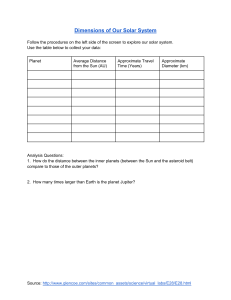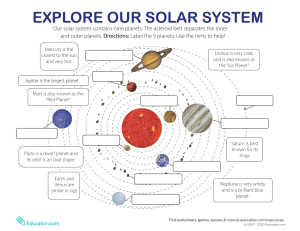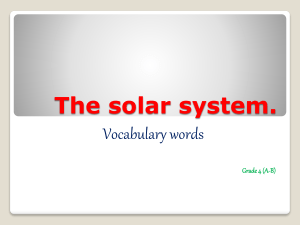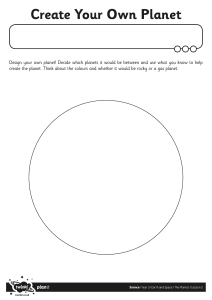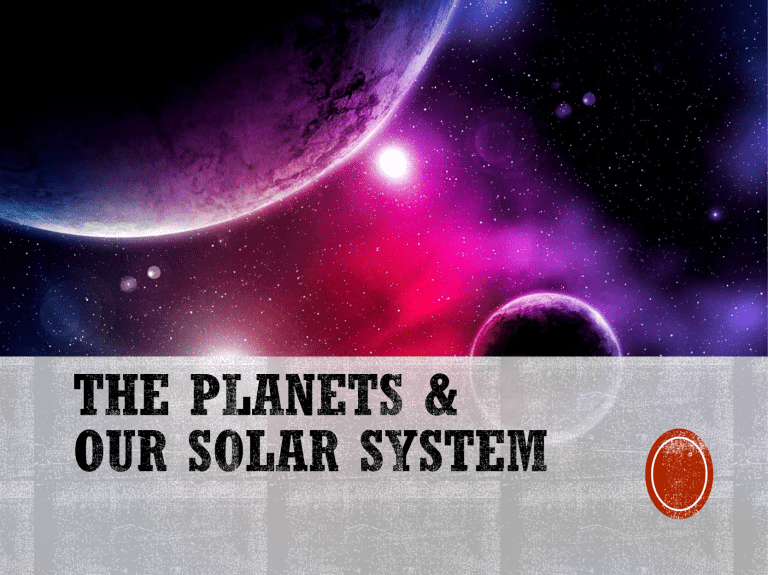
OBJECTS IN OUR SOLAR SYSTEM Our solar system is made up of the sun, eight planets, their moons or satellites (about 166 in our solar system), dwarf planets, comets, asteroids and meteors… The planets in our solar system can be divided into two groups, based on their location in relation to our sun and their physical make up. Inner planets Outer planets There is also a natural dividing line between the two: The Asteroid Belt THE INNER PLANETS Mercury – the closest planet to the sun, with the shortest orbit. It is about half the size of Earth’s moon Does not have any moons or rings. A solar day on the surface of Mercury lasts 176 Earth days. Smallest planet. Your weight on Mercury would be 38% of your weight on Earth. A year on Mercury takes 88 Earth days. Mercury is just 4,879 Kilometres across its equator, compared with 12,742 Kilometres for the Earth. Mercury is the second densest planet. THE INNER PLANETS Venus – about the same size as Earth and the hottest planet Venus does not have any moons or rings. Venus is nearly as big as the Earth with a diameter of 12,104 km. A day on the surface of Venus (solar day) would appear to take 117 Earth days. A year on Venus takes 225 Earth days. Venus rotates in the opposite direction to most other planets. The surface temperature on Venus can reach 471 °C. THE INNER PLANETS Earth - the only planet that has liquid water and that supports complex life Earth has a powerful magnetic field. There is only one natural satellite of the planet Earth. The Earth is the densest planet in the Solar System. It has water in the 3 states of matter 510.06 million km² THE INNER PLANETS Mars - sometimes called the “Red Planet” because of its red, iron-oxide soil. Mars and Earth have approximately the same landmass. Mars is home to the tallest mountain in the solar system. It also has 2 moons. Only 18 missions to Mars have been successful (out of 40). On Mars the Sun appears about half the size as it does on Earth ASTEROID BELT Asteroid Belt objects are made of rock and stone The size of the objects within our own asteroid belt range from being as small as a dust particle to almost 1000km wide. The four largest objects in the belt are Ceres, Vesta, Pallas, and Hygiea. Sometimes gravitational forces can throw asteroids out of the belt and send them towards the inner solar system. We know about 7,000 of these space rocks right now! Although it is the largest asteroid in our solar system, Ceres was designated as a newly classified dwarf planet. About 1 million km between asteroids THE OUTER PLANETS - ARE THE 4 FARTHEST PLANETS FROM THE SUN, GAS GIANTS (MOSTLY HYDROGEN AND HELIUM), AND ARE MORE MASSIVE THAN THE INNER PLANETS THE OUTER PLANETS Jupiter - the largest planet in our solar system. Eleven Earths could fit across Jupiter’s equator. If Earth were the size of a grape, Jupiter would be the size of a basketball. Shortest day of all the planets. - 9 hours and 55 minutes. Jupiter orbits the Sun once every 11.8 Earth years. The Great Red Spot is a huge storm on Jupiter (350 years). Between 80 and 95 moons. Eight spacecraft have visited Jupiter. THE OUTER PLANETS Saturn - has wide and bright rings and about 60 moons. Saturn is the most distant planet that can be seen with the naked eye. Saturn is the flattest planet. - 10 hours and 34 minutes Saturn orbits the Sun once every 29.4 Earth years. Made mostly of hydrogen. 150 moons. Titan is a moon with complex and dense nitrogen-rich atmosphere. Composed mostly of water ice and rock. THE OUTER PLANETS Uranus - has about 27 moons and a faint ring Uranus was officially discovered by Sir William Herschel in 1781. Uranus is often referred to as an “ice giant” planet. Uranus hits the coldest temperatures of any planet. -224°C Uranus makes one trip around the Sun every 84 Earth years. THE OUTER PLANETS Neptune - has about 13 moons, a faint ring and is considered to be the windiest planet in the solar system Neptune is the most distant planet from the Sun. Neptune is the smallest gas giant. A year on Neptune lasts 165 Earth years. Neptune has 6 faint rings. SIZE SCALE The Solar System to scale - YouTube Pluto used to be considered a planet until 2006… In 2006, the International Astronomical Union defined a planet as a body that orbits the sun, is spherical, and is large enough to clear its orbit. They reclassified Pluto as a “dwarf planet” because it is not large enough to clear a path around its orbit (to clear its own orbit means a planet has become gravitationally dominant, and there are no other bodies of comparable size other than its own satellites or those otherwise under its gravitational influence.) a body that revolves around a planet. This could be “natural” like a planet's moon(s) or “man-made” like a communications satellite. Every planet in our solar system, except Mercury and Venus, has at least one natural satellite, or moon (a body that orbits a planet). Mercury – 0 Venus – 0 Earth – 1 Mars – 2 Jupiter – 80 Saturn – 150 Uranus – 27 Neptune – 13 JUPITER AND ONE OF ITS 60+ MOONS PLANET RINGS The gas giants all have rings, though some are pretty faint. Planet rings are made of tiny bits of dust, ice crystals, and small pieces of rock (RID = rock, ice, dust). ASTEROIDS & THE ASTEROID BELT Asteroids are small, rocky objects that move around the sun. Most of them are scattered in a large area between the orbit paths of Mars and Jupiter called “the asteroid belt”, and rarely move through other parts of the solar system. A Comet is a small mass of dust and ice that orbits the sun in a long, ovalshaped path. When a comet’s orbit takes it close to the sun, some of the ice on the comet’s surface changes to water vapor and streams out to form a long, glowing tail. Halley’s Comet, one comet that is visible to Earth, takes 77 years to complete its path. METEORITE The Law of universal gravitation (gravity): All objects in the universe are attracted to all other objects. This attraction is observable only when the masses of the objects are huge (i.e.: planets and the sun). The first law of motion (inertia): A moving object will continue to move (in a straight line) until an outside force acts on it. The balance between these two forces, inertia and gravitation, also keeps Earth in orbit around the sun. It also keeps other planets and their moons in their particular orbits. Question: Why doesn’t gravity cause the moon to fall to the Earth? Answer: The Earth's gravity pulls everything toward the Earth. In order to orbit the Earth, the velocity of a body, like the moon, must be great enough to overcome the downward force of gravity. Because the moon is moving very rapidly and because there is almost no air resistance to slow it down, it falls at the same rate as Earth’s surface curves. This is the same thing that happens with other objects that orbit other objects – moons around other planets and planets around the sun. The moon circles Earth in a path called an orbit (the path one body in space takes as it revolves around another body). The moon’s orbit is the path that results when inertia and gravitation act together. Gravitation between the Earth and the moon keep the moon from flying off into space because of its inertia.

